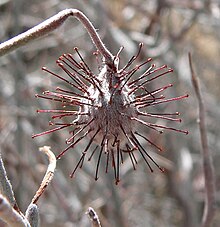Krameria bicolor is a perennial shrub or subshrub of the family Krameriaceae, the rhatanies. It is commonly known as white rhatany, crimson-beak, and chacate in Spanish (cosahui in the state of Sonora). It is found in drier environments of the southwestern United States from California to Texas, and in northern Mexico.
| Krameria bicolor | |
|---|---|

| |
| barbed fruit | |
| Scientific classification | |
| Kingdom: | Plantae |
| Clade: | Tracheophytes |
| Clade: | Angiosperms |
| Clade: | Eudicots |
| Clade: | Rosids |
| Order: | Zygophyllales |
| Family: | Krameriaceae |
| Genus: | Krameria |
| Species: | K. bicolor
|
| Binomial name | |
| Krameria bicolor | |
| Synonyms | |
It is a low lying, densely branched shrub, commonly up to 2 feet (1 m), but exceptionally to beyond 5.0 feet (2 m). The branches are spreading, with thorn-like tips. The leaves are grey-green to greenish, finely-haired, narrow and only one half to three quarters of an inch long.
The color of the plant and branches is grayish-green to gray, or whitish-gray, to dull browns or tinged with red. The flowers are often sparse and sometimes inconspicuous, but plants in some locales can bloom prolifically in red flowers. The plant is used for dyes in the basketry of Seri people in Mexico.
The shrub is adapted to dry, desert environments, but it can take advantage of high soil moisture. The plant is partially parasitic, for example on creosote bush, Larrea tridentata.
References
edit- Jepson Flora Project: Krameria grayi
- USDA: NRCS: Plants Profile Krameria grayi; Photo-High Res--(Close-up) - (Photo of Flowers, Spines, & Leaves)
- Images from the CalPhotos archive
- Krameria grayi at LBJ Wildflower Center